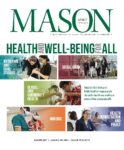Much of what Ayman Fatima knows about George Mason IV’s manservant James consists of educated guesses because historical records often left out enslaved people.
According to Fatima, James—who may have also gone by the name of Jammy—did everything for the founding father, including carrying him around his home (Mason suffered from gout) and traveling with him to Williamsburg, Virginia, and to Philadelphia.
The narrative that the George Mason University student built about James is based on small puzzle pieces, such as wills and letters, or bills of sale that might detail the kind of clothes he wore. Even so, she says it is unclear what happened to James in the end.
Fatima, who is double majoring in systems engineering and government and international politics, discovered this information while working as a research assistant on the Enslaved Children of George Mason Project. The project’s goal is to tell the previously untold stories of those who were enslaved by the university’s namesake, George Mason IV, and it comes at a time when many universities are examining their histories.
In 2016, inspired by Honors College student questions about the enslaved people of Gunston Hall, Mason School of Integrative Studies and history professor Wendi Manuel-Scott and Benedict Carton, Robert T. Hawkes Professor of History, applied for a grant through the university’s Office of Student Scholarship, Creative Activities, and Research (OSCAR) to dig into the past. They sought to find out more about those living at Gunston Hall, Mason’s historic home located in Mason Neck about 20 miles from the Fairfax Campus.
“What we discovered, as faculty and students, is that we still have to wrestle with slavery as an institution even if we were not complicit as an institution in the system of slavery,” says Manuel-Scott.
The stories gathered by the students have been compiled in an online archive, also called the Enslaved Children of George Mason (ECGM). The project has also sparked a number of classes at Mason that integrate this research and the ideas it explored.
Manuel-Scott says she hopes that the students’ work shows other students and the community the power of expanding the historical narrative and the value of adding voices—especially from individuals who are rarely heard—to traditional narratives like those of George Mason and the Founding Fathers.
Fatima agrees.
“It is important for our campus community to recognize that our university’s namesake enslaved blacks and that his Declaration of Rights did not extend to those he enslaved—because we can only begin to move forward once we have accepted our past,” she says. “Through the ECGM project, we can start doing that at Mason. I chose to join the project so that I could be a part of this important work.”
Fatima and four other students—global affairs major Alexis Bracey, history major Kye Farrow, criminology, law and society major Elizabeth Perez-Garcia, and applied statistics major Farhaj Murshed—started with the project in summer 2017.
Perez-Garcia studied the women in Mason’s life, including his wife and mother, and also found very little documentation about their lives. She finally found a court case at the Library of Congress that involved Anne Mason, George Mason’s mother, regarding property questions after Mason’s father died. Locating the document wasn’t easy—Perez-Garcia needed to apply for a special library card to look through the special collections material. She says even the librarians weren’t aware of that document, given that it was rare for women to deal with legal matters at that time.
“It goes to show how there are these little nuggets of information hidden in places like the Library of Congress that are just labeled as ‘other’ or ‘nonimportant,’” Perez-Garcia says.
Murshed delved into the diet and medical treatment of enslaved people at Gunston Hall, and Farrow investigated how laws governing individual liberty affected enslaved individuals. Bracey looked at the enslaved children of Gunston Hall, the Mason family’s relationship with the slave trade, and the culture of the enslaved community.
The project did not stop at the summer’s end, as the Enslaved Children of George Mason Project was the start of a wider exploration of the lives of Mason and those around him. Fenwick Library history librarian George Oberle, BA History ’96, MA History ’98, PhD History ’16, who helped the students with their archival searches, teaches an honors course and history classes that integrate the project’s findings.
Through this class, an online journal called Mason’s Legacies has been started with items and exhibits added by students and invited scholars that dive deep into Mason’s history. Oberle says the site will provide students the opportunity to use the Mason family as a lens to explore slavery, westward expansion, and other aspects of American history.
Manuel-Scott, Carton, Oberle, and several of the students made a presentation about both the project and a planned Enslaved People of George Mason memorial (see sidebar) at a Board of Visitors meeting this past spring.
“One of the things that this project does is confront the full legacy of our namesake in a way that speaks to who we are as Mason, in a way that’s courageous, in a way that exemplifies what we do best as a university,” says Julian Williams, Mason’s vice president of compliance, diversity, and ethics. “And that is to turn student questions into action, into work with faculty members, and to make that into something that’s long-lasting.”
Preston Williams contributed to this feature.


No Comments Yet »
Leave a comment